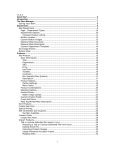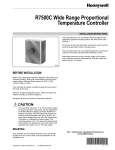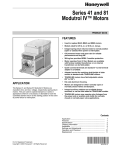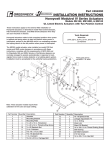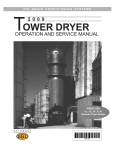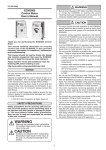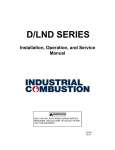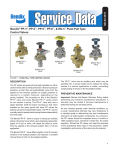Download BENDIX BW1443 User's Manual
Transcript
SD-03-3411 ® Bendix® MV-1™ Modutrol VALVE A VALVE B 5-3/8” VALVE E VALVE C VALVE D FIGURE 1 - MV-1™ MODUTROL DESCRIPTION ® ™ The Bendix MV-1 modutrol assembly is an integrated air control module designed for dash mounting in a truck/tractor. The bodies for the modutrol assembly, as well as for the “spool” inserts, are molded of a nonmetallic, noncorrosive material. The assembly consists of three push-pull type valves and two optional lever type valves. All valves utilize a spool “insert,” which can be replaced from the front of the assembly without removal of the assembly or connecting air lines. The three push-pull type valves provide the following functions: 2. Trailer service air supply. 3. System park. 4. Trailer park only. 5. Trailer recharge with tractor spring brakes applied. Reference Figs. 1 & 5, valves V-1 and V-2 utilize identical spool “inserts.” The functions of valves V-1 and V-2 are essentially the same as the Bendix® PP-1™ control valve. Valve V-3 utilizes a spool “insert” consisting of two valves; a nonautomatic push-pull function similar to that of the Bendix® PP-8™ valve, and a pilot operated three-way valve similar to that of the Bendix® SV-1™ valve. 1. Tractor protection control. 1 The optional lever type valves housed in the auxiliary control module consist of one or two lever type valves which may be used to control any on/off type auxiliary devices such as a sliding fifth wheel, inter-axle lockout, etc. OPERATING MODE V-1 The function as the lever type valves is similar to the Bendix® TW-1™ control valve. One or both of the valves may be utilized and, if required, a nonfunctional spool insert may be replaced by a functional spool insert at any time. Port identification for the push-pull module is shown on Fig. 6 and for the auxiliary module on Fig. 9. V-2 V-3 NORMAL RUN BUTTON IN. DELIVERY SUPPLIES BOTH SECTIONS OF V-3 (PP-8™ AND SV-1™ VALVE). BUTTON IN. DELIVERY TO TRACTOR SPRING BRAKES AND TO PILOT SECTION OF PILOT VALVE (SV-1™). TRACTOR BRAKES RELEASED. BUTTON OUT. UPPER PORTION BLOCKS SUPPLY AIR FROM V-1. LOWER PILOT VALVE (SV-1™) HELD OPEN BY DELIVERY FROM V-2 PERMITTING V-3 DELIVERY TO TRAILER SUPPLY LINE. TRAILER BRAKES RELEASED. SYSTEM PARK (POSSIBLY AUTOMATIC IF SUPPLY PRESSURE IS LOW.) BUTTON IN. DELIVERY SUPPLIES BOTH SECTIONS OF V-3 (PP-8™ AND SV-1™ VALVE). BUTTON OUT. EXHAUSTS AIR FROM TRACTOR SPRING BRAKES AND FROM PILOT SECTION OF PILOT VALVE (SV-1™). TRACTOR BRAKES APPLIED. BUTTON OUT. UPPER PORTION BLOCKS SUPPLY AIR FROM V-1. LOWER PILOT VALVE (SV-1™) IN EXHAUST POSITION EXHAUSTING AIR FROM TRAILER SUPPLY LINE. TRAILER BRAKES APPLIED. TRAILER PARK (POSSIBLY AUTOMATIC IF SUPPLY PRESSURE IS LOW.) BUTTON OUT. EXHAUSTS ALL SUPPLY AIR FROM V-3 (PP-8™ AND SV-1™ VALVE). BUTTON IN. DELIVERY TO TRACTOR SPRING BRAKES AND PILOT SECTION (SV-1™). TRACTOR BRAKES RELEASED. BUTTON IN OR OUT. NO SUPPLY AIR. PILOT VALVE (SV-1™) IN EXHAUST POSITION VENTING TRAILER SUPPLY LINE. TRAILER BRAKES APPLIED. TRAILER RE-SUPPLY BUTTON IN. DELIVERY SUPPLIES BOTH SECTIONS OF V-3 (PP-8™ AND SV-1™ VALVE). BUTTON OUT. EXHAUST AIR FROM TRACTOR SPRING BRAKES AND FROM PILOT SECTION (SV-1™). TRACTOR BRAKES APPLIED. BUTTON IN. SUPPLY AIR FROM V-1 IS DELIVERED THROUGH UPPER CAVITY TO TRAILER SUPPLY LINE. TRAILER BRAKES RELEASED. FIGURE 2 - MODUTROL OPERATING MODES 2 OPERATION OPERATING AND LEAKAGE TESTS The three push-pull control valves control all the required functions of tractor spring brake control and trailer air supply. The operating modes are detailed in Fig. 2 and in the descriptive write-up which follows. Prior to testing for leakage and function of the components in either module, the knobs must first be removed from the push-pull valves and then any panel cover plate or escutcheon plates removed so that the top of the spool assemblies and the retaining rings that hold the spools in place are visible. INITIAL CHARGE Without air pressure in any part of the system, valve buttons V-1, V-2, and V-3 are out. When system pressure reaches 60 psi, valve buttons V-1 and V-3 may be pushed in and air will be delivered through valve V-3 charging the trailer system. The trailer parking brakes (whether spring or air applied) will release; however, the tractor spring brakes remain applied. Pushing valve button V-2 in will release tractor spring brakes. NORMAL RUN POSITION With valve buttons V-1, V-2, in and V-3 out, air is being supplied to the trailer, all parking brakes are released and the system is in the normal run position. ACTUATION OF TRAILER BRAKES ONLY To actuate only the trailer brakes, valve button V-1 is pulled out. This action exhausts the air supply from the trailer supply line, causing the tractor protection valve to close. Typical use of this mode would be to apply trailer brakes before uncoupling. This mode would be used during a tractor “bob-tail” operation. MANUAL SYSTEM PARK To apply the parking brakes on both tractor and trailer, valve button V-2 is pulled out. NOTE: If the trailer is not equipped with spring brakes (pre-121), it is desirable to release the trailer emergency application and provide a “demonstrated park” (proven holding ability via tractor spring brakes only). This may be done by positioning valve button V-1 “IN,” V-2 button “OUT,” and pushing button V-3 “IN.” This action recharges the trailer supply line, releases the trailer brakes and allows the tractor spring brakes to demonstrate their ability to hold both the tractor and trailer in a parked position. AUTOMATIC SYSTEM PARK If the supply or delivery pressure for the push-pull module is reduced, either valve buttons, V-1 or V-2, or both will pop out automatically when the supply pressure is between 35-45 psi. When button V-1 pops out, the trailer supply line will vent to atmosphere, applying trailer brakes; should button V-2 pop out, the tractor spring brakes will also apply as well as the trailer. For an operational test of the push-pull module, a test gauge should be connected to a tractor spring brake line and one to the trailer supply hose. Function of the push-pull valves may then be checked per the chart, Fig. 3. PUSH-PULL MODULE OPERATIONAL TEST AIR DELIVERY AIR DELIVERY VALVE TO TRACTOR TO TRAILER SUPPLY POSITION SPRING SUPPLY PRESSURE V-1 V-2 V-3 BRAKES HOSE 100 PSI IN OUT OUT ZERO ZERO IN IN OUT 100 PSI 100 PSI IN OUT IN ZERO 100 PSI OUT IN* OUT 100 PSI ZERO 100 PSI IN IN OUT 100 PSI 100 PSI REDUCING TO 35-45 PSI OUT OUT OUT ZERO ZERO *When V-2 is pushed IN, V-3 should pop OUT. FIGURE 3 PUSH-PULL MODULE LEAKAGE CHART 100 PSI SUPPLY PRESSURE FOR ALL TESTS VALVE POSITION V-1 V-2 V-3 Leakage Symptoms Correction OUT OUT OUT Valve V-1 at S-1 Replace spool (Around Stem) assembly in V-1 Valve V-2 at S-2 Replace spool (Around Stem) assembly in V-2 OUT OUT OUT Valve V-1 at S-3 Replace spool assembly in V-1 Valve V-2 at S-4 Replace spool assembly in V-2 Exhaust Port P-6 Replace spool in V-1 or V-2 as required IN OUT OUT Valve V-3 at S-5 Replace spool in V-3 Valve V-3 at S-6 Replace spool in V-3 Exhaust Port P-6 Replace spool in V-1 or V-3 as required OUT IN OUT Exhaust Port P-6 Replace spool in V-2 or V-3 as required IN OUT IN Exhaust Port P-6 Replace spool assembly in V-1 or V-3 FIGURE 4 3 VALVE V-1 S-1 VALVE V-2 S-2 S-3 VALVE V-3 S-4 S-6 S-5 P-6 FIGURE 5 - PUSH-PULL VALVE LEAKAGE KEY AUXILIARY MODULE LEAKAGE CHART P-2 P-3 (SUPPLY) OPERATING MODE (SUPPLY CHARGED TO 100 PSI) VALVE POSITION T-1 T-2 OFF OFF Leakage Symptoms S-1 S-4 Exhaust Hole Exhaust Hole P-5 (DELIVERY TO TRAILER AIR SUPPLY ON P-6 (EXHAUST) FIGURE 6 - TRACTOR SPRING BRAKE DELIVERY 4 ON Exhaust Hole Exhaust Hole FIGURE 7 Correction Replace in T-1 Replace in T-2 P-7 Replace in T-1 P-8 Replace in T-2 P-7 Replace in T-1 P-8 Replace in T-2 spool assy. spool assy. spool assy. spool assy. spool assy. spool assy. VALVE T-1 VALVE T-2 S-1 P-7 S-4 P-8 FIGURE 8 T-2 DELIVERY (P-3) SUPPLY P-1 P-2 P-5 T-1 DELIVERY (P-4) P-6 SUPPLY FIGURE 9 5 Leakage of the push-pull valves may then be checked per the chart shown on Fig. 4 and the key shown on Fig. 5. A normal supply pressure of 100 psi at supply port P-3 is assumed for these leakage tests. Leakage may be checked by a soap solution. NOTE: Take care in not allowing excessive soap solution in valve. The auxiliary on/off module may be checked for leakage per chart shown on Fig. 7 and key 8, again assuming a 100 psi supply pressure at any one of the four supply ports. REMOVING AND REPLACING SPOOL INSERT ASSEMBLY Release all air pressure from the supply to the module. Remove the retaining ring from the cavity involved, pull out the spool assembly and replace with a new spool. The spool will normally be packaged with pre-lubricated o-rings; however, should additional lubricant be required, BW-650M (Dow Corning 55-M) should be used (Bendix piece number 291126). The push-pull assemblies may be installed without regard to radial orientation; however, the lever type on/off spool assemblies must be installed with the operating lever in either the horizontal or vertical position. NOTE: The segment on the bottom of the spool must match the appropriate notch in the bottom of the cavity. If the spool is not properly located, the retaining ring cannot be installed. If leakage persists after changing spool assemblies, the body casting may be at fault. Check threaded bosses for cracks. The interior walls should be examined carefully for scratches or grooves, which would prevent static o-rings on the spool assembly from sealing. If this condition persists, the complete module should be replaced with genuine Bendix parts. Replacement spool assemblies or nonfunctional plugs are available at authorized Bendix parts outlets. WARNING! PLEASE READ AND FOLLOW THESE INSTRUCTIONS TO AVOID PERSONAL INJURY OR DEATH: When working on or around a vehicle, the following general precautions should be observed at all times. 1. Park the vehicle on a level surface, apply the parking brakes, and always block the wheels. Always wear safety glasses. 2. Stop the engine and remove ignition key when working under or around the vehicle. When working in the engine compartment, the engine should be shut off and the ignition key should be removed. Where circumstances require that the engine be in operation, EXTREME CAUTION should be used to prevent personal injury resulting from contact with moving, rotating, leaking, heated or electrically charged components. 3. Do not attempt to install, remove, disassemble or assemble a component until you have read and thoroughly understand the recommended procedures. Use only the proper tools and observe all precautions pertaining to use of those tools. 4. If the work is being performed on the vehicle’s air brake system, or any auxiliary pressurized air systems, make certain to drain the air pressure from all reservoirs before beginning ANY work on the vehicle. If the vehicle is equipped with an AD-IS™ air dryer system or a dryer reservoir module, be sure to drain the purge reservoir. 5. Following the vehicle manufacturer’s recommended procedures, deactivate the electrical system in a manner that safely removes all electrical power from the vehicle. 6. Never exceed manufacturer’s recommended pressures. 7. Never connect or disconnect a hose or line containing pressure; it may whip. Never remove a component or plug unless you are certain all system pressure has been depleted. 8. Use only genuine Bendix ® replacement parts, components and kits. Replacement hardware, tubing, hose, fittings, etc. must be of equivalent size, type and strength as original equipment and be designed specifically for such applications and systems. 9. Components with stripped threads or damaged parts should be replaced rather than repaired. Do not attempt repairs requiring machining or welding unless specifically stated and approved by the vehicle and component manufacturer. 10. Prior to returning the vehicle to service, make certain all components and systems are restored to their proper operating condition. BW1443 © 2004 Bendix Commercial Vehicle Systems LLC. All rights reserved. 3/2004 Printed in U.S.A. 6






